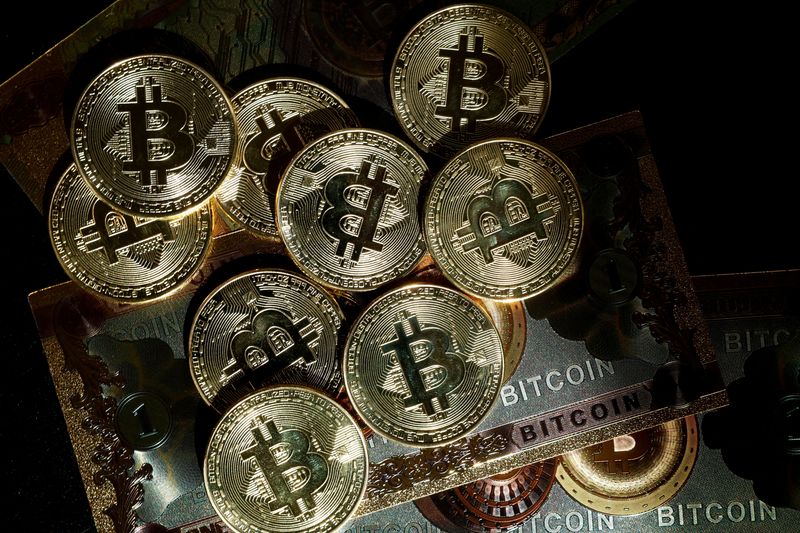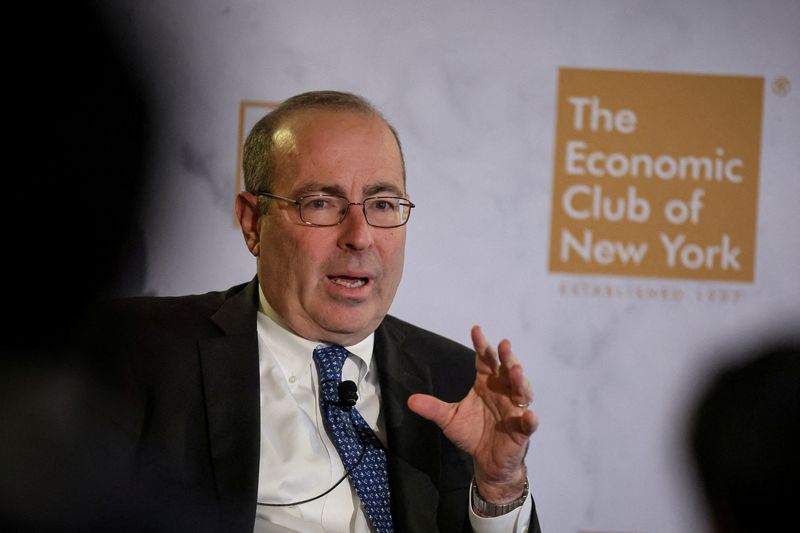Select Language

By Hannah Lang and Laura Matthews
(Reuters) -Bitcoin broke through the $90,000 level on Wednesday, to an all-time high in a rally showing no signs of easing on expectations that Donald Trump as U.S. president will be a boon for cryptocurrencies.
The world's biggest cryptocurrency has become one of the most eye-catching movers in the week since the election and on Wednesday touched a record of $93,480 before paring gains.
It was last down slightly at $88,185, but has risen 32% since the Nov. 5 election.
Smaller peer ether has also risen 37% since Election Day, while dogecoin, an alternative, volatile token promoted by billionaire Trump-ally Elon Musk was up more than 150%.
"What you've seen since the election is the market hoping or realizing what that could mean for bitcoin in the medium to long term – a pro-bitcoin administration, Senate and potential legislation that not only gives U.S. citizens the right to self-custody bitcoin but potentially for bitcoin to be a strategic reserve asset for the U.S. Treasury," said Damon Polistina, head of research at Eaglebrook.
Regulatory uncertainty has been a major cloud hanging over the sector and a headwind to advisors allocating for their clients to bitcoin, he said.
Trump embraced digital assets during his campaign, promising to make the United States the "crypto capital of the planet" and to accumulate a national stockpile of bitcoin.
It is unclear how or when that could happen but the possibility drove a speculative surge in crypto mining and trading stocks.
Zach Pandl, head of research at Grayscale Investments, said the "election results will open up the ability for large, regulated businesses like banks, custodians and exchanges to engage with public blockchain technology in the way that they haven't in the past."
Software (ETR:SOWGn) company and bitcoin investor MicroStrategy announced it had spent about $2 billion buying bitcoin between Oct. 31 and Nov. 10. Shares scaled a record high on Tuesday.
Crypto investors see an end to increased scrutiny from the Securities and Exchange Commission under Trump. Trump and his sons announced a new crypto business, World Liberty Financial, in September.
"Many people believe that we will inevitably get to bitcoin at $100k," said JJ Kinahan, CEO of IG North America and president of its tastytrade retail brokerage.
"I expect bitcoin to continue building momentum, at least until after the inauguration when we find out what the real plans to get there are."
Others advised investors against getting caught up in the crypto frenzy.
"With bitcoin reaching $90K and hitting a new all-time high, investors should be cautious about the potential volatility ahead," said Georgi Koreli, CEO of Hinkal, a blockchain-based private trading platform. "This doesn't mean that we will not see $95K or even $100K soon, but rather that BTC might pause or slide back to regain its strength."

TOKYO (Reuters) - The Japanese government is making arrangements to compile a supplementary budget of about 13.5 trillion yen ($87 billion) to fund a stimulus package to help low-income households and offset rising prices, the Sankei newspaper reported late on Wednesday.
Under the plan, the government would provide 30,000 yen ($193) to low-income households that are exempt from paying residential taxes, and 20,000 yen per child for households with families, the paper said.
It is also considering restarting subsidies for electricity and gas prices from January to respond to high fuel costs, media reports have said.
Prime Minister Shigeru Ishiba is looking to finalise the stimulus package on Nov. 22, the Sankei said.
($1 = 155.3700 yen)

By Matt Tracy
(Reuters) - Banks raised $23.5 billion by issuing investment-grade bonds on Tuesday, the biggest debt issuance by financial institutions in a single day since the beginning of 2016, as they anticipate potentially higher interest rates next year.
The $23.5 billion in debt issued by financial institutions accounted for 78% of Tuesday's total $30.15 billion in high-grade bond sales, which was the fifth-largest day of overall issuance in 2024, according to a Wednesday report by BMO Capital Markets.
"From yesterday's flood of issuance, it seems like banks are issuing bonds now to get ahead of what could happen next year with rates" under President-elect Donald Trump's administration, said Jack McIntyre, global fixed income portfolio manager at Brandywine Global.
"(We) will have to see what happens with risk, assets, uncertainty and volatility the rest of the year into the new year."
Tuesday's largest note offering came from HSBC, which sold $6.5 billion in bonds to fund a tender offer for the bank's notes due in 2025 and 2026, according to International Financing Review.
Other banks that issued debt on Tuesday include BNP Paribas SA (ETR:BNPP), Citigroup (NYSE:C), Goldman Sachs, Huntington Bancshares (NASDAQ:HBAN), Societe Generale (OTC:SCGLY) and Westpac.
Yankee banks, or non-U.S. banks which tapped the domestic market, accounted for $14.5 billion of Tuesday's supply, BMO said. This is the fourth-largest day of Yankee bank supply in at least eight years, BMO added.
Demand for Tuesday's sales was strong at over three times the volume on offer, according to BMO.

By Daniel Trotta and Eric Beech
(Reuters) -U.S. President-elect Donald Trump on Tuesday named Elon Musk to a role aimed at creating a more efficient government, handing even more influence to the world's richest man who donated millions of dollars to helping Trump get elected.
Musk and former Republican presidential candidate Vivek Ramaswamy will co-lead a newly created Department of Government Efficiency, an entity Trump indicated will operate outside the confines of government.
Trump said in a statement that Musk and Ramaswamy "will pave the way for my Administration to dismantle Government Bureaucracy, slash excess regulations, cut wasteful expenditures, and restructure Federal Agencies."
Trump said the new department will realize long-held Republican dreams and "provide advice and guidance from outside of government," signaling the Musk and Ramaswamy roles would be informal, without requiring Senate approval and allowing Musk to remain the head of electric car company Tesla (NASDAQ:TSLA), social media platform X and rocket company SpaceX.
The new department would work with the White House and Office of Management & Budget to "drive large scale structural reform, and create an entrepreneurial approach" to government never seen before, Trump said.
The work would conclude by July 4, 2026 - the 250th anniversary of the signing of the Declaration of Independence.
Musk, ranked by Forbes as the richest person in the world, already stood to benefit from Trump's victory, with the billionaire entrepreneur expected to wield extraordinary influence to help his companies and secure favorable government treatment.
With many links to Washington, Musk gave millions of dollars to support Trump's presidential campaign and made public appearances with him.
Adding a government portfolio to Musk's plate could benefit the market value of his companies and favored businesses such as artificial intelligence and cryptocurrency.
"It's clear that Musk will have a massive role in the Trump White House with his increasing reach clearly across many federal agencies," equities analyst Daniel Ives of Wedbush Securities said in a research note.
"We believe the major benefits for Musk and Tesla far outweigh any negatives as this continues to be a 'poker move for the ages' by Musk betting on Trump," Ives said.
The move was criticized by Public Citizen, a progressive consumer rights NGO that challenged several of Trump’s first-term policies.
"Musk not only knows nothing about government efficiency and regulation, his own businesses have regularly run afoul of the very rules he will be in position to attack in his new ‘czar’ position," Lisa Gilbert, co-president of Public Citizen, said in a statement. "This is the ultimate corporate corruption."
MAXIMUM TRANSPARENCY PROMISED
Trump likened the efficiency effort to the Manhattan Project, the U.S. undertaking to build the atomic bomb that helped end World War Two, while Musk promised transparency.
"All actions of the Department of Government Efficiency will be posted online for maximum transparency," Musk said on X, inviting the public to provide tips.
"We will also have a leaderboard for most insanely dumb spending of your tax dollars. This will be both extremely tragic and extremely entertaining," Musk said.
Musk said at a Trump rally at Madison Square Garden in October that the federal budget could be reduced by "at least" $2 trillion. Discretionary spending, including defense spending, is estimated to total $1.9 trillion out of $6.75 trillion in total federal outlays for fiscal 2024, according to the Congressional Budget Office.
"Your money is being wasted and the Department of Government Efficiency is going to fix that. We're going to get the government off your back and out of your pocketbook," Musk said at the rally.
The acronym of the new department - DOGE - also references the name of the cryptocurrency dogecoin that Musk promotes.
In August Musk and Tesla won the dismissal of a federal lawsuit accusing them of defrauding investors by hyping dogecoin and conducting insider trading, causing billions of dollars of losses.
Dogecoin has more than doubled since Election Day, tracking a surge in cryptocurrency markets on expectations of a softer regulatory ride under a Trump administration.
Shares in Tesla fell on Wall Street ahead of the announcement but are up about 30% since the election.
Ramaswamy is the founder of a pharmaceutical company who ran for the Republican presidential nomination against Trump and then threw his support behind the former president after dropping out.
In his 2021 bestseller "Woke, Inc.," Ramaswamy decried decisions by some big companies to base business strategy around social justice and climate change concerns.
Ramaswamy said the appointment means he is withdrawing from consideration for the pending U.S. Senate appointment in Ohio, where Governor Mike DeWine will appoint a replacement for JD (NASDAQ:JD) Vance, who will become Trump's vice president when they are inaugurated on Jan. 20.

TOKYO (Reuters) -Leading chipmaker Nvidia (NASDAQ:NVDA) and SoftBank (TYO:9984) Corp, the telecommunications arm of SoftBank Group, have piloted the world's first artificial intelligence (AI) and 5G telecoms network, the two companies said on Wednesday.
The network can run AI and 5G workloads concurrently, a process known as an artificial intelligence radio access network (AI-RAN), the companies said.
Applications for the network include autonomous vehicle remote support and robotics control.
"Every other telco will have to follow this new wave," SoftBank Group CEO Masayoshi Son said at an AI event where he was speaking alongside Nvidia CEO Jensen Huang.
Huang said SoftBank was the first to receive its new Blackwell chip designs, which it is incorporating into the AI supercomputer it is developing to create its own generative AI model.

By Jihoon Lee and Hyunjoo Jin
SEOUL (Reuters) - Shares in Samsung Electronics (KS:005930), the world's top memory chip maker, fell on Wednesday to their lowest level in more than four years amid worries about the impact of U.S. tariffs under a new Donald Trump administration, analysts said.
The South Korean tech giant is the worst performing stock among global chipmakers like TSMC and Nvidia (NASDAQ:NVDA) this year, as it has lagged behind rivals in tapping booming demand for artificial intelligence chips.
Trump's potential tariffs on Chinese imports are seen dealing a bigger blow to Samsung, which has a higher reliance on Chinese customers than its local rival SK Hynix, said Lee Min-hee, an analyst at BNK Investment & Securities.
Hynix has been increasing sales of high-end AI server chips to U.S. customers like Nvidia.
Trump has threatened to impose a universal 10% tariff on imports and 60% on Chinese goods, which would reduce demand for electronics products that use chips, said Greg Noh, an analyst at Hyundai Motor (OTC:HYMTF) Securities.
Last week, South Korean President Yoon Suk Yeol also raised concerns that Trump's threat of steep tariffs on Chinese imports could prompt Chinese rivals to slash export prices and undercut Korean chip firms overseas.
Samsung shares are down 34% in the year-to-date and on course to post their worst annual performance in more than two decades. Shares in SK Hynix have risen 32% so far this year, and U.S. chipmaker Nvidia has gained 199%.
Samsung shares, South Korea's most valuable stock, extended declines to a fourth straight session, down 2.1% as of 0126 GMT, after falling as much as 2.5% to 51,700 won, the lowest since June 24, 2020, while the broader KOSPI market fell 1.5%.
SK Hynix rose as much as 2%, after falling for two consecutive sessions.

Investing.com-- U.S. stock index futures fell in evening deals on Tuesday as a rally in Wall Street, following Donald Trump’s election victory, fizzled out as caution kicked in ahead of key inflation data.
Sentiment was also rattled by some hawkish comments from Federal Reserve officials, who warned that any increases in inflation could elicit a hold on interest rates.
Losses in futures came after Wall Street indexes retreated from recent peaks during Tuesday’s session.
S&P 500 Futures fell 0.1% to 6,005.0 points, while Nasdaq 100 Futures fell 0.2% to 21,146.75 points by 18:38 ET (23:38 GMT). Dow Jones Futures fell 0.1% to 44,034.0 points.
Trump-fueled rally fizzles as CPI data looms
Investors were seen locking in some profits after Trump’s election victory sparked sharp stock gains over the past week.
This rally also appeared to have paused as investors sought more clarity on what a second Trump presidency will look like, given that the president-elect has maintained a protectionist stance towards trade and immigration.
A Trump presidency is also expected to potentially push up inflation in the long term.
These doubts grew ahead of key consumer price index inflation data, which is due on Wednesday. The reading is expected to show inflation remained steady in October, sparking some doubts over just how much impetus the Fed has to keep cutting interest rates.
Minneapolis Fed President Neel Kashkari warned on Tuesday that any surprises in inflation could see the Fed keep rates steady in December. His comments saw traders pricing in a 59.8% chance that the Fed will cut interest rates by 25 basis points in December, and a 40.2% chance rates will remain unchanged, according to CME Fedwatch.
The central bank had last week cut rates by 25 bps and reiterated its data-drive approach to further easing.
Wall St retreats from record highs
Wall Street indexes fell from record highs on Tuesday as investors locked in a measure of recent gains. Caution before the CPI reading also weighed, as the dollar and Treasury yields appreciated sharply.
The S&P 500 fell 0.3% to 5,983.99 points, while the NASDAQ Composite fell 0.1% to 19,282.76 points. The Dow Jones Industrial Average slid 0.9% to 43,910.98 points.
Among major aftermarket movers, Rivian Automotive Inc (NASDAQ:RIVN) surged over 8% after the electric vehicle maker and Volkswagen AG (ETR:VOWG) announced an increased investment by the German automaker in a joint venture.
Spotify Technology (NYSE:SPOT) rose 7% after it clocked strong subscriber growth for the September quarter while issuing a solid forecast for the year.

By Ann Saphir
(Reuters) -The Federal Reserve's policy rate continues to act as a brake on the resilient labor market and on inflation that is still above the 2% target, two U.S. central bankers said on Tuesday, a view that appears to argue for more interest rate cuts, even as both signaled they were not ready to judge how fast or by how much.
"In my judgment we are still in a modestly contractionary stance, but ultimately the economy will guide us, in terms of how far we are needing to go" in cutting the Fed's benchmark for short-term borrowing costs, Minneapolis Fed President Neel Kashkari said at a Yahoo Finance event.
Speaking earlier, Richmond Fed President Thomas Barkin called the current level of rates "somewhat less restrictive" than it had been, and said he could see scenarios where demand rises and the central bank needs to focus on containing inflation, and others where businesses start laying off workers and it needs to turn more to protecting the job market.
"With the economy now in a good place and interest rates off their recent peak but also off their historic lows, the Fed is in position to respond appropriately regardless of how the economy evolves," Barkin said at an event in Baltimore.
The Fed cut its policy rate last week by a quarter of a percentage point to the 4.50%-4.75% range. Short-term borrowing costs are now 75 basis points below where they were two months ago, just before the central bank started reducing rates to bring them more in line with falling inflation and what appeared to be a quickly cooling labor market.
In September, Fed policymaker projections were consistent with another quarter-percentage-point rate cut in December, and four more like-sized reductions next year, bringing the policy rate to the 3.25%-3.50% range.
Since then, a lot has happened that could complicate the central bank's next steps.
Inflation by the Fed's targeted measure was 2.1% in September, just above its target, but measures of underlying inflation that strip out volatile energy and food prices have been stuck higher, with little sign of recent progress. Economists expect more of the same when the U.S. Labor Department releases the consumer price index for October on Wednesday.
Monthly job gains have dropped, but unemployment, at 4.1%, is low by historical standards. Policymakers are watching for signs of further weakening - which would suggest the need for more rate cuts - or of continued resilience, and they will get just one more monthly employment report before their Dec. 17-18 meeting.
NEW ADMINISTRATION
Republican President-elect Donald Trump's victory in last week's election also creates fresh uncertainty. Trump, who will take over from Democratic President Joe Biden in January, has promised to cut taxes, impose new tariffs on imports, and deport a record number of immigrants. While financial markets have generally moved to price in faster economic growth and fewer interest rate cuts as a result, central bankers say they can't plan a response until it's clear exactly what policies will be enacted.
Asked what could prompt the Fed to pause rate cuts at the December meeting, Kashkari said he feels there is too little time between now and then for the data to show a reheating of the labor market.
"I think there'd have to be a surprise on the inflation front to change the outlook so dramatically," Kashkari said. "The bigger question long run is where are we going to settle?"
Kashkari said he believes the level of borrowing costs that neither stimulates nor restricts the economy - the so-called neutral rate - is likely higher than in the past, perhaps because productivity has increased.
Although a higher neutral rate could be one argument for fewer rate cuts ahead, Kashkari steered clear of making predictions, as did Barkin.
"I think we all agree we are above neutral now," Kashkari said. "But over the course of the next year, we're going to get a lot more information about where neutral is."

(Reuters) -U.S. President-elect Donald Trump has picked South Dakota Governor Kristi Noem to serve as the next secretary of the Department of Homeland Security, CNN reported on Tuesday, citing two sources.
Noem, once seen as a possible running mate for Republican Trump, is currently serving her second four-year term as South Dakota's governor after a landslide reelection victory in 2022. She rose to national prominence after refusing to impose a statewide mask mandate during the COVID-19 pandemic.
However, Noem had a turbulent few months politically this year.
She faced widespread backlash in April this year when she wrote in a memoir that she shot to death an "untrainable" dog that she "hated" on her family farm, following which some Trump advisers said they believed that Noem's stock had fallen in the former president's eyes at the time when she was still a VP contender.
Both Trump's campaign and Noem's office did not respond to requests for comments outside regular business hours.
The Department of Homeland Security is responsible for everything from border protection and immigration to disaster response and the U.S. Secret Service.
Trump on Monday appointed Tom Homan as his administration's incoming "border czar". Homan said he will prioritize deporting illegal immigrants who pose threats to public safety and national security.
Sources told Reuters on Monday that Trump was expected to tap U.S. Senator Marco Rubio to be his secretary of state.

(This Nov. 8 story has been refiled to drop the repetition of Xi's title and to correct the spelling of his given name, in paragraph 6)
By Marco Aquino
LIMA (Reuters) - Peru and China will sign an updated free-trade agreement during President Xi Jinping's upcoming visit to the Andean nation that would boost commerce by at least 50% between the countries, Peru's foreign minister said on Friday.
In an interview with Reuters, Minister Elmer Schialer said the Chinese president would travel to Peru with a delegation of 400 business people interested in investing in infrastructure and technology projects in the country.
The free-trade agreement was originally signed in 2009 and the "optimized" version will be signed alongside 30 other agreements designed to improve cooperation between the countries.
"China is our main trading partner, experts say this will increase that dynamism by at least 50%," Schialer said. Bilateral trade between the two countries reached nearly $36 billion last year according to data from the Peruvian Ministry of Commerce.
China has large mining and infrastructure projects in the country, including the Chancay mega port by Cosco Shipping Port.
"The port will launch Peru to another level of trade," Schialer said. The port will be "virtually" inaugurated by Peruvian President Dina Boluarte and Xi from the government palace in Lima on Nov. 14.
Schialer added that Peru's portfolio of mining projects totals $54 billion while its infrastructure projects yet to be developed total $157 billion. He noted that "China is particularly interested" in these projects.
The minister said he doesn't expect changes with the United States given the recent election of President-elect Donald Trump.
"The only thing we hope for and are sure that will happen is an expansion of the United States' presence in investments," he said, adding that both the outgoing and incoming US administration have "given us clear signals of interest" in terms of investment.

